Gigabyte GA-P55M-UD2 - P55 uATX Goodness for Under $105 - Updated
by Gary Key on August 28, 2009 12:00 PM EST- Posted in
- Gary's First Looks
We will finish up our P55 previews this weekend (or later) with a couple of new boards from ASUS and Biostar. In the meantime, I just wanted to comment on the Gigabyte GA-P55M-UD2. I have over a dozen P55 boards in the labs with several more arriving shortly. Already, two motherboards have risen to the top in regards to overclocking performance and a couple of boards have really impressed me with their balance of great performance and excellent feature sets.
That said, this particular board has been the most fun so far in testing. However, I will confess that I am partial to solid performing, budget priced, uATX form factor boards so my comments on these products tend to have some rah-rah in them if they perform well. Speaking of performance, I cannot comment on the numbers due to the NDA. Even though we have half a dozen retail purchased processors, memory kits, coolers, and this motherboard, Intel is sticking to their guns about violating the NDA release on i5/P55.
So that leaves me with providing vague comments like the board having a very good performance to price ratio. Maybe something along the lines of "I just cannot believe it does not cost more" is appropriate considering the feature set and performance compared to a few other boards.
This does not mean the board is going to hit 272 Bclks or provide class leading performance. It just means that spending less than $105 for this board and pairing it up with a Core i5-750 is going to lead to some fun times for the P55 budget seekers, HTPC groupies, or the SFF gaming crowd. We have word from ASRock and Foxconn that they will be providing $100 uATX P55 boards but we have not seen the feature sets yet.
Let's take a quick look at the GA-P55M-UD2. I forgot to mention, you can purchase this board now (as we did) from Provantage for less than $105. Update - The board is sold out again but should be in back in stock shortly, probably at less than $100.

Considering the limited board space, Gigabyte did a very good job fitting all of the peripherals onto this board. About the only negatives we can think of is the continued inclusion of the floppy drive port and the lack of passive cooling for the MOSFET area. The board only sports two fan headers so that might also be a problem for users with two or more 3-pin case fans. The board does support CrossFireX operation although we highly recommend against this setup as the second PCIe x16 slot is actually an x4 electrical slot running off the P55 chipset. The board contains Gigabyte's UltraDurable 3 technology that features their 2oz. copper based PCB, solid capacitors, low RDS(on) MOSFETs, and ferrite core chokes.
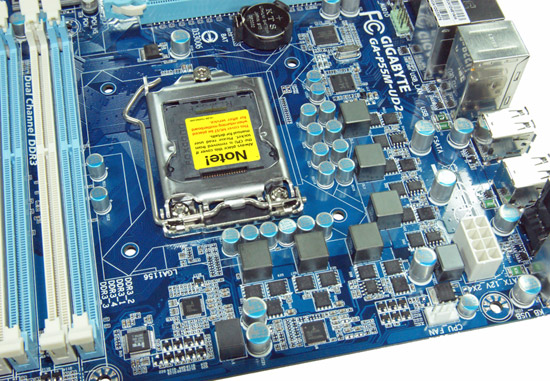
Gigabyte utilizes a solid six-phase PWM setup on this board. The CPU area is open for the most part and will accommodate larger coolers like the Thermalright MUX 120. Large push/pull coolers like the Vigor Monsoon III LT will block the first DIMM slot. If you plan on running this board with Bclk rates above 170 or so, we suggest additional airflow across the MOSFETs to ensure 24/7 stability when overclocking.
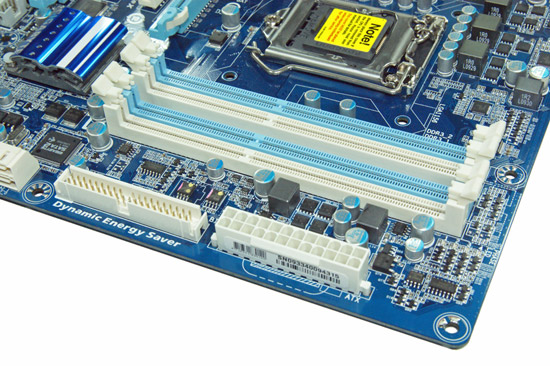
The IDE port, 24-pin ATX power connector, and the four DIMM slots are located in the lower right hand corner of the board. This board supports dual channel memory configurations and 16GB of DDR3 memory when using 4GB DIMMS. Installing the memory with a video card inserted in the first slot is difficult but not impossible.
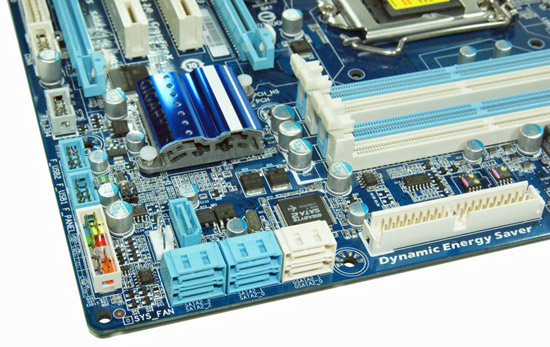
There are five (blue) SATA 3Gb/s ports provided by the P55 chipset that support RAID 0, 1, 5, 10. The sixth port available on the P55 (under the blue heatsink) is utilized on the I/O panel for eSATA. Gigabyte includes the JMicron JMB363 3Gb/s SATA chip that drives the two white SATA ports and provides IDE support. The front panel header, two USB headers, and the IEEE 1394a header are located at the edge of the board.
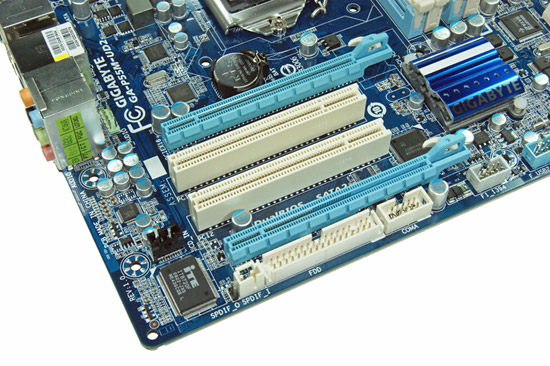
Gigabyte includes two PCIe x16 slots (x16 operation for the first slot, x4 operation for the second slot) and two PCI slots. The first PCI slot will be unavailable when utilizing a dual slot video card.
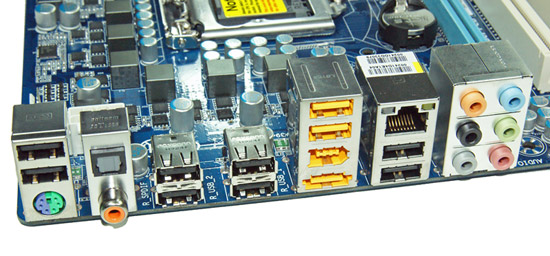
Last but not least is the I/O panel. We have ten USB 2.0 ports (total of fourteen on the board), combination PS/2 port, single eSATA port, IEEE 1394a port offered by the TI TSB43AB23 chipset, Gigabit Ethernet LAN port via the Realtek RTL8111D chipset, optical out/coaxial out S/PDIF ports, and the audio panel that provides 8-channel audio output via the Realtek ALC 888B HD audio codec.
BIOS Information
Apparently this preview did not have enough substance in it according to a few reader comments. I totally agree. However, I will state this one more time, we are bound by an NDA and cannot provide that substance for another week or so. That said, we can now show the general layout of the BIOS, thus providing a little more substance than we had yesterday. I will leave it at that for now.

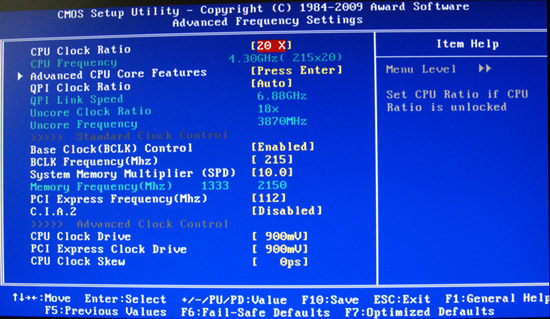
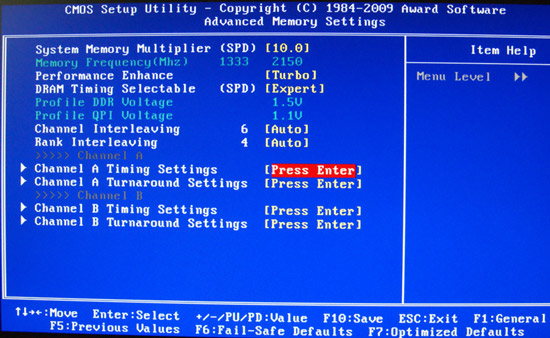


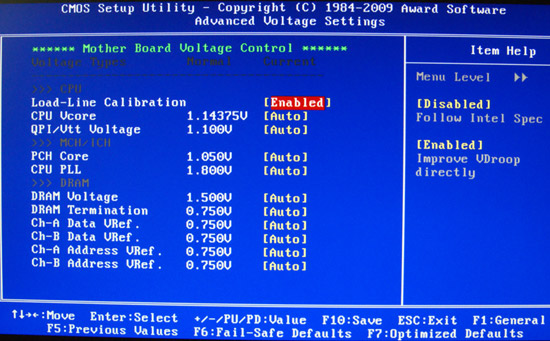






















76 Comments
View All Comments
charlie2 - Monday, August 31, 2009 - link
edit: sentenceBut then I never claimed to be great did I? LOL
boogerlad - Friday, August 28, 2009 - link
Just shutup! All you do is complain about how bad it performs. At a significantly lower price, you get about i7 920 performance. It's supposed to be "brain damaged"!I don't see you doing any reviews for the community, so stop complaining. Perhaps you don't understand what a nda is.
TA152H - Saturday, August 29, 2009 - link
Actually, I did write an article for another site, and it took me over 100 hours to write, and was much more informative than this junk that has no information. I won't push the link, since it would be self-serving and not appropriate for another site, but, you can do a search on History of Mainframes on Google if you're interested. I wasn't crazy about the editing, but, the amount of effort put in the article should be obvious, compared to this plain crap.My main complaint, if you could actually read, is there's no information on it. It's annoying as Hell to keep hoping they have something, and they shamelessly have nothing, for article after article. This site is getting really bad. I don't know why they're so stupid to keep pushing bad articles to get page reads, when each time they hurt their reputation. It's short sighted.
When you talk about performance, you're talking about something you don't understand. We haven't seen performance numbers. That's the problem. The pre-release numbers were horrid, but I can't imagine they won't be improved on. But, even if they are, it's a tough situation for the processor. The real i7 is better with memory performance, and you can expect better video as well. Most morons, which probably includes you, will think because the PCI-E controller is on the processor, you'll get better performance. I expect it will be worse because of this. Keep in mind, the processor is already lobotomized with a narrower memory bus, and now keep in mind that the data traveling from the video card now has to go to the processor, since that's where the PCI-E controller is. With all the lost pins compared to LGA1366, you increase the problem by putting more pressure on the i/o of the processor. I haven't see the specs, but, it's pretty much assured you won't have separate pins for this, so you'll have contention.
It's a little similar as with the IGPs. They slow processor performance because they share main memory, creating memory contention. AMD was smart by putting sideport memory, and removing that. But, it's only a little similar. There doesn't seem an easy solution to this, except to add more pins, and Intel removed a ton of pins, not added them. So, it's very possible to expect a drop in processor performance, and video performance in some situations, because of this contention.
It's an inelegant design. It's brain-damaged. It surrounded by excellent processors above it, and below it. The Core 2 will still make more sense for most people, because it's a better platform for IGPs (since the memory controller is not on the processor, you don't face the problem of accessing the processor for memory moves, or adding the additional circuitry on the IGP itself), it's much smaller, and thus easier to make, and uses a lot less power. Above it, it's going to clock lower than the real i7s, because it's got more on it, and will have more points that can fail, and will generate more heat. It's also slower, and has some serious compromises built in. The pricing has to be artificially low to make a lot of sense, or the pricing of the competitors (from Intel, AMD isn't really much of a competitor) has to be artificially high.
From a technical point of view, this processor doesn't seem to have much validity to it. Intel can make it work by the aforementioned pricing, but really, I think they would have been better off by just letting the normal pricing evaporation work for the LGA1366 platform. The Core 2 will be a useful chip for long enough to let that happen, especially if they would boost the clock speeds like they are very able to do.
But, again, I'm really just annoyed there's never any real data. They just keep throwing out crap, and, probably I am not alone in thinking they can't possibly put out another useless article. So, I read it, and realize they have. And then idiots like you, actually like it.
Please, don't breed. Do your part in preventing rampant and continuing stupidity.
nightic - Friday, September 4, 2009 - link
Some writer.Glass houses...
Please. Learn, to. Use. Punctuation, correctly.
PassingBy - Monday, August 31, 2009 - link
C2 isn't a better platform for IGPs. Clarkale is at least as good as C2 plus GMCH.goinginstyle - Monday, August 31, 2009 - link
So basically, you are at AnandTech railing about a blog preview on a P55 board when your own editor (Chris A.) is doing the same at Tom's on a weekly basis but you refuse to comment on his articles. I would think you would have at least responded to the fact that Chris forces you to go through eight or more pages of pictures for what Gary did in one page here. So is your only purpose here to run down AT so you can get a job at Toms? I doubt they hire based on stupidity, but if they do, then you should be chief editor shortly.By the way, your Mainframe article was one of the most boring articles I have ever read at Tom's. If you spent a 100 hours on it then I think you must ride the short bus to work everyday. I could have googled that information and completed the same cut and paste hack job into a word document in about four hours. Add another two hours for copying images from various websites and maybe another hour of horrid editing for a total of seven hours.
yyrkoon - Wednesday, September 9, 2009 - link
"So is your only purpose here to run down AT so you can get a job at Toms?"Have you read any toms articles lately ? I keep trying myself, but constantly find my self disappointed ( as I was a once long standing user of theirs until articles like all the Mac vs PC crap started floating about ). Spewing gibberish, and trying to make things seem true, or factual when people already know it for what it is.
This is not to say they do not have articles that I once in a while pop in to check out. This however is only because no other sites have "reviewed" equipment that I am interested in. This is also rare.
Gary Key - Monday, August 31, 2009 - link
Actually, I really wish I could give you actual numbers at this time. As I clearly stated, we are bound by the NDA even though our components were purchased at various retail outlets. The actual numbers would probably surprise you and I think several of your comments would be properly addressed, although maybe not to your satisfaction. ;)This is not an article, it is a blog and pictorial preview at that, as I have done with the others. The reason being is that people would like basic information on the boards before launch. The reason I know this is that personal messages and emails for those who like these previews outnumber those who do not by about 1000 to 1.
I would much rather being doing an article about these boards but that will have to wait another week. In regards to time spent, well I have about 800 hours invested so far in P55 testing. As far as the i7 boards, we will take a look at four new boards in the sub $200 category and compare them directly to the P55 products in two weeks. After that, we have a complete top to bottom AMD chipset article that consists of seventeen boards or so. In the meantime, I have been working on the two launch articles for P55 next week.
:)
strikeback03 - Monday, August 31, 2009 - link
You should just let someone "break into" your labs, run some tests, and post some results ;)ClagMaster - Saturday, August 29, 2009 - link
@TA152UYour discussion of your percieved weaknesses of i5 was actually interesting until you called a forum poster (either tacoburrito or boogerlad) a moron. This is not good. You would have been more effective if you refrained from such characterization of a person who simply does not understand. Why not try to educate, enlighten and persuade him without arrogance, pride and insult.
I too would like more concrete data about i5/P55 performance. But I also understand and accept Anandtech is under legal obligation under the NDA. After the NDA is expired, we can look forward to a very comprehensive article of i5/P55 performance.
The direct PCI-E link to the Lynnfield CPU is hardly a crippling disadvantage. A direct PCI-E link involves implementation of another on-die controller with its own resources. This is no different than the on-die memory controller that already exists on both Lynnfield and Bloomfield. This is an efficiency, not a disadvantage, for the simple reason data transmitted through the PCI-E does not have to be processed by an X58 Northbridge, and then routed through QPI to the CPU. In Lynnfield PCI-E data goes directly to the CPU via a much faster, lower latency controller. Same idea as the on-die memory controller present (and desirable)on Lynnfield and Bloomfield.
What you have posted about this feature and its detrimental effect on i5/i7 performance does not make sense. This Lynnfield feature is actually a major advancement over your beloved Bloomfield which relies on the X58 Northbridge/QPI for PCI-E connectivity.